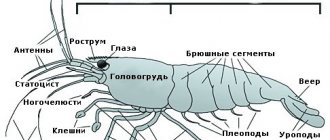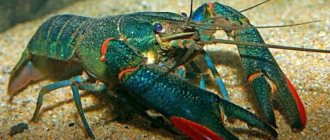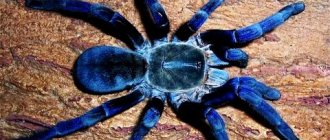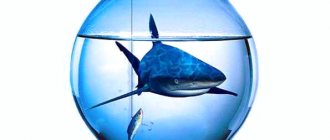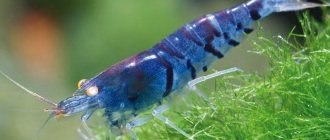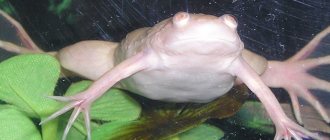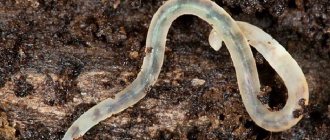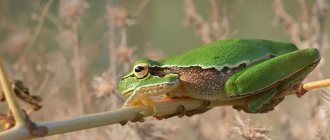Shrimp farming in Russia has great commercial potential, since this niche in our country has not yet been filled. In supermarkets and restaurants, the price tag for this delicacy is indecently high, so an idea for a start-up creeps into your head.
If you want to start your own business, but have not yet decided on a business idea, then you have come to the right place. Today we will look at the shrimp topic from A to Z. Where should you start? How and where to breed this animal? What investments will be required? And how much can you ultimately earn?
Where are shrimp bred?
Artificial cultivation and breeding of shrimp is possible in three ways:
- In open waters.
- In special artificial water pools.
- In home aquariums.
By analyzing each method separately, you can find the most attractive one for yourself. After all, it all depends on what end result the future business is aimed at.
Breeding shrimp in open waters
Shrimp feel good at water temperatures from + 22 °C. Therefore, this version of shrimp farming is more suitable for hot countries, where the thermometer constantly stays at high temperatures. The leaders here are Asian countries - Thailand, Vietnam.
If we talk about Russia, then the shrimp business in open reservoirs can only be established in the southern regions, and then using a special method: In the cold months (from October to May), shrimp spend the winter in warm indoor pools. For the summer season (May-October), the shrimp are moved to a natural reservoir - a dam enclosed by a mesh.
But in our country we can expect various climatic surprises, and in the summer the weather may be far from summer. Therefore, it is better to give preference to the following method of farming.
Growing shrimp in an artificial pond
Shrimp cultivation, both at home and on an industrial scale, is organized by creating a so-called shrimp farm . With our harsh climate, this is the most acceptable option.
In general terms, this process looks like this: shrimp are kept in special pools where the water is constantly heated, purified and oxygenated. To create and maintain comfortable living conditions for crustaceans, you will need a warm, bright room and the installation of a closed water supply system, which will be discussed further.
You can create such a farm at home, if space allows, in a warm garage, or by renting an industrial space.
Edible individuals
Crustaceans belonging to edible species must be kept in larger containers. A small pond in a summer cottage is suitable for this. For more modest production, you can choose a large aquarium.
Containers should be equipped in the same way as for their decorative counterparts. Moss, ferns and other plants need to be placed in them. Vegetation for an aquarium has a small price. Before buying livestock, you need to prepare an aquarium or pond by landscaping it.
Types of meat arthropods:
- freshwater;
- royal;
- brindle;
- Malaysian.
Each type of shrimp has its own conditions.
For breeding king shrimp and other species, it is important to observe the temperature regime, because these creatures are thermophilic. It is unacceptable to cool the water below +22°C. But if crustaceans are kept in an equipped pool, which is located indoors and maintained at temperature, they can be propagated all year round. Such a pool costs from 20 thousand rubles.
Don't put too many shrimp in one bucket. Free space is important for their comfortable living. In addition, some species do not get along with each other. Therefore, you will have to settle on one variety or purchase several containers.
Growing shrimp in an aquarium
Breeding shrimp in an aquarium is more suitable for decorative purposes. Here it is better to focus on aquarists who are ready to buy exotic species of shrimp for their collections.
But by purchasing several larger aquariums, you can grow shrimp for food sales, but in small quantities. Growing crustaceans in aquarium conditions is no easier than in false reservoirs. It is also necessary to create an ecosystem that is as close as possible to the normal habitat conditions of this living creature.
But this is a good opportunity to gain experience in breeding shrimp and creating optimal conditions for their life. After such preparation, it is easier to move on to creating a farm.
Installation of RAS (closed water supply system)
So , the most successful option for business is to create artificial “shrimp farms”. Here you will be required to recreate the usual habitat conditions of crustaceans. A special device will help with this - installation of a closed water supply . It is needed to purify water from unnecessary impurities, saturate it with oxygen, and heat the pool. The closed water supply system consists of the following technical modules:
- A swimming pool with a volume of 1-2 tons, a depth of 1-1.5 meters, with a drain for water.
- Mechanical filter. It works on the principle of a washing machine drum.
- The water drained from the pool passes through a fine mesh drum and is cleaned of impurities.
- Biological filter. Special bacteria are responsible for purifying water from toxic substances (nitrites, ammonia) produced by shrimp during their life processes.
- Storage tanks for water replacement. This is where fresh water and filtered pool water are mixed. Excess water is removed and fresh water is added. Typically, a pump for water circulation and a heating system are built in here.
- A device for saturating water with oxygen.
- Ultraviolet disinfection.
- This is the continuous purification cycle that water undergoes in a special closed water supply unit.
Typical beginner mistakes
Newbies often start building a business based on their own experience, so they repeat the same mistakes. They strive to immediately launch large capacities, without having any experience in shrimp farming.
Many beginning entrepreneurs try to save money on equipment, since it is very expensive. For example, they purchase manually assembled units. But such equipment often turns out to be of poor quality. If there are problems with the installation, you will have to do the repairs yourself. Therefore, it is better to buy proven equipment so that there are no problems with it.
Water requirements for shrimp farming
The water in which the shrimp will be kept must meet certain parameters: Optimum temperature 24-28 C. The critical point is considered to be a temperature of 13°C, at which the shrimp die.
Qualitative composition of the aquatic environment:
- Indicator Concentration
- Oxygen (mg/g) 4-6
- Nitrites (mg/g) 0.25-0.35
- Nitrates (mg/g) 1.5-3
- Chlorides (mg/g) no more than 10
- Ammonium nitrogen (mg/l) 0.5-1.5
- Acidity level (pH) 9-10 units.
All standards must be monitored using the RAS system.
Description
Freshwater shrimp have a special build, which is expressed in multi-leggedness. Thanks to small legs, individuals can not only move, but also perform various actions (for example, assisting in breathing). The body of freshwater shrimp is divided into a cephalothorax and an abdominal region. In the cephalothorax area the main part of the crustacean’s legs is concentrated and the eyes and antennae are located.
In the area of the peritoneum, individuals have additional legs that facilitate movement in the water surface and bearing offspring. The anterior part of the thorax segments is fused with the head. If shrimp move with their hind legs, then with their front legs they carry food to the oral cavity. The presence of a carapace allows you to protect the chest and head.
Powerful jaws are capable of crushing and crushing food. Thanks to the blade located in the jaw area, water circulates in the gills. With the help of legs on the abdominal cavity, females can hold eggs. Stalked eyes enable crustaceans to turn.
Requirements for an artificial reservoir
When equipping shrimp tanks, it is important to adhere to the following rules:
- pool depth is at least 1 meter;
- the more spacious the container, the better (you should start from 1 ton);
- The material of the pool is not of fundamental importance (concrete, plastic, PVC);
- The bottom of a false reservoir must be equipped with original shelters where shrimp can hide from their relatives, because There are frequent cases of eating each other.
- It is enough to throw available materials to the bottom - pipe scraps, slate, bricks, branches, stones.
Possible difficulties
Shrimp reproduce during the periods between molts. The female is capable of bearing up to 18-20 eggs at a time. Small freshwater crustaceans live 12-16 months. This period is quite enough to overpopulate ponds with intensive reproduction. However, lack of proper care reduces the life expectancy of individuals. Shrimp die en masse, never reaching marketable weight. In this case, fry constantly have to be purchased from other people’s farms. In this case, financial costs increase, and profits cover maintenance costs.
How and where to buy shrimp for farming
The largest scale shrimp farms are located in Southeast Asia. However, delivery of live individuals from there is very expensive. In addition, they simply may not survive long-term transportation.
The best option is to find shrimp farms closer to your region. But the problem is that in Russia there is only one official farm specializing in growing Pacific white shrimp - “Russian Shrimp” in the Kaluga region. Therefore, you will have to look for private aqua farms nearby. And here it is important to ensure the quality of the planting material by studying the conditions under which the crustaceans are kept.
What to do with the offspring
If decorative shrimp are grown, they can be sold to aquarists or taken to a special store.
Selling shrimp intended for human consumption is more difficult. They can be offered to individuals by posting an advertisement or entering into agreements with restaurants, cafes and other food establishments. But, in this case, you will have to draw up documents for the activity.
@Joergelman pixabay.com
In the first year, the cost of breeding shrimp on a special farm, taking into account the rental of premises and the purchase of equipment, will cost 1.5 million rubles. A business for breeding decorative varieties in your own apartment will cost less, but will not be as large-scale.
The shrimp business in Russia is new, so a desperate entrepreneur can try to realize himself in this area. The main disadvantage is that you will have to invest a lot of money without the most reliable prospect of getting more.
How to breed shrimp correctly
In order to competently build a shrimp business, it is important to know the household preferences of pets in terms of:
- feeding;
- content;
- reproduction;
- raising offspring.
But first things first.
Feeding the shrimp
Under natural conditions, shrimp are omnivores, and it is not for nothing that they are called marine orderlies. They eat algae, fish, moss, their own discarded shells, and even their fellow creatures. But in artificial conditions, an entrepreneur needs to take care of a balanced diet. So, the shrimp diet looks like this:
- special dry food (fish food is also suitable);
- “live” food – bloodworms, Artemia larvae, tubifex, cyclops;
- chopped seafood (cod, squid, pollock);
- plant food (algae, various aquarium plants or other greens
- (spinach, nettle, burdock), pieces of vegetables and fruits processed with boiling water (carrots, pumpkin)
Food is supplied to the pool as needed, when all previous food has been eaten. It is better to remove stale remains so as not to pollute the water.
Content
In addition to water quality and constant maintenance of the microclimate on the farm, the future owner of crustaceans should know that one tank should not be too densely populated. Overpopulation is fraught with cannibalism, which will lead to a decrease in natural growth, and in the future, profits. Experts advise maintaining the following proportions in settlement - no more than 10 individuals per 1 sq. meter.
Reproduction
Shrimp reproduce successfully in captivity. Sexual maturity in individuals begins at 5 months of age. After fertilization, the females are placed in a cooler pool (temperature up to 22 degrees), where they bear offspring for 2-3 weeks. After this period, the temperature in the “shrimp maternity hospital” is raised to normal levels (27-28 degrees), and the females produce offspring.
Care
Freshwater shrimp can live not only in a large body of water, but also in a small aquarium. However, when introducing fry, it is worth remembering that the number of shrimp to keep in a reservoir is based on the calculation of 1 shrimp for every liter of water. For large breeds of crustaceans, the calculation formula changes - each individual requires 3-4 liters of water.
When the water temperature decreases, it is worth considering that the mobility of the inhabitants of the aquatic environment is significantly reduced. Too low a temperature can lead to the death of the wards.
It is important to organize water changes every 7-10 days. Compliance with this condition helps ensure the normal functioning of the inhabitants of the aquatic environment. To replace water, liquid that has been settled and heated to the required temperature should be used.
It is important to keep the water chemistry under control. The presence of copper in the composition is unacceptable.
Before settling an aquarium or pond, it is important to take care of planting:
- Java moss;
- hornwort;
- pistia;
- Cladaphora.
Timely feeding of the wards, systematic change of water and ensuring normal temperature are the main conditions that are important to observe when caring for crustaceans.
Growing technology
After birth, the fry are placed in a separate tank with salt water (12 ppm). Sea water can be obtained by adding a special salt mixture to the pool. The temperature regime is maintained within 27-29 degrees.
At first, the fry require very finely ground food. Alternatively, yeast, spirulina, special starter feed for young animals. After about a month, the postlarval stage begins, when the babies begin to resemble adult shrimp. This is a signal for gradual desalination of water. The salinity level is reduced by half, and they gradually switch to fresh water.
There is a transition to adult food. Grown-up shrimp are transferred to a common pool of fresh water, where their further life cycle occurs. After 6 months they are ready to breed, and after a year they can be caught for sale, since they have already gained sufficient weight (70-100 grams).
Malaysian giants
Crustaceans are best suited for farming in Russia. They are very large, can reach a length of up to 33 cm, grow quickly and reproduce rapidly. In addition, they are unpretentious in care and nutrition.
Development to an adult organism occurs in several stages. The most difficult period is the molting period. Throughout its existence, the shrimp molts 13 times, each time becoming larger. Adult organisms undergo molting once every 8 weeks. During this period, most of the individuals may die. Therefore, at this difficult moment you need to carefully monitor the living conditions of the shrimp.
Crustaceans are purchased as young animals. The females are immediately placed in a separate container, in which the water temperature for the first 3 weeks is kept within +20...+22°C. After 21 days it is increased to +30°C.
These shrimp eat food crops.
Favorable water temperature for reproduction is +20°...+27°C. Stones, pieces of wood and pipes are used at the bottom of an aquarium, pool or pond. They are needed for shelter. The number of shrimp in one container should not be excessive, otherwise the individuals will begin to devour each other, which brings huge losses to the business.
Malaysian shrimp are offered grass and feed crops. They are also very fond of waste that is generated as a result of processing animal products. Crustaceans can remember where they eat. If individuals get hungry, they begin to gather there. When breeding, they need to be fed generously. Individuals are ready to breed at 6 months.
Shrimp market
Depending on the scale of your activity, there are 3 options for selling shrimp:
- To pet stores and aquarists, if you breed ornamental shrimp.
- For private individuals. Such sales are suitable for those who decide to start a business without official registration. Products can be advertised on social networks or on a specially created website.
- Retail chains, cafes, pubs, restaurants and sushi delivery, export. This is the most profitable business, but it is necessary to obtain permits. We'll talk about it a little later.
Domestic shrimpers
Feature of domestic shrimp farmers: The production unit is much smaller than an industrial farm to fit inside a household. This is an amazing benefit - smaller systems are inherently easier to manage, avoiding unnecessary problems. When the tank is only 12 feet (3.66 meters) wide instead of an acre (0.4 hectare), it is easier to detect and fix problems. For example, detecting uneaten food or a case of death from an infection in a small volume is much easier and faster, without causing damage.
How much money do you need to start a business?
Let's look at capital investments using the example of creating a shrimp farm. For the startup we will need:
- Industrial premises with utilities (water, sewerage, electricity). Area 120 – 150 sq. m. Annual rent 180,000 rubles.
- Utility bills – 150,000 rubles.
- Equipment (swimming pools, RAS, generator) - 500,000 rubles. You can take smaller and cheaper units, or used ones, but we look at the average price tag for the country.
- Purchase of shrimp stock (1,000 individuals) or fry for breeding – 30,000 rubles.
- The annual supply of feed is 120,000 rubles.
- Hired workers - 300,000 rubles. Someone must monitor the condition of the pools, water indicators, and temperature.
- That is, to create a more or less liquid farm at the initial stage, we will need about 1,300,000 rubles. With such investments it is possible to produce up to 5 tons of seafood per year. From the second year, we exclude expenses for equipment and young animals, and we get about 750,000 rubles in annual investments.
Diseases
Shrimp are susceptible to diseases. Most often, individuals suffer from parasites that are concentrated in the shell area. Gradually, the parasites begin to penetrate muscle tissue and gills, affecting the nervous system and heart muscle. It is impossible to cure crustaceans from this disease. Individuals die quickly.
By keeping the pond clean, the possibility of fungus occurring cannot be ruled out. A fungal infection, having infected the shrimp, sucks out the nutrients from them, poisoning the crustacean’s body with toxins. Shrimp also suffer from viral diseases, which are extremely difficult to cure.
When a disease is detected in an individual, it is very important to isolate it as soon as possible. In this case, the water from the reservoir should be drained and filled with clean water. After this, you need to consult with a veterinary specialist who will help you accurately diagnose and prescribe appropriate treatment.
